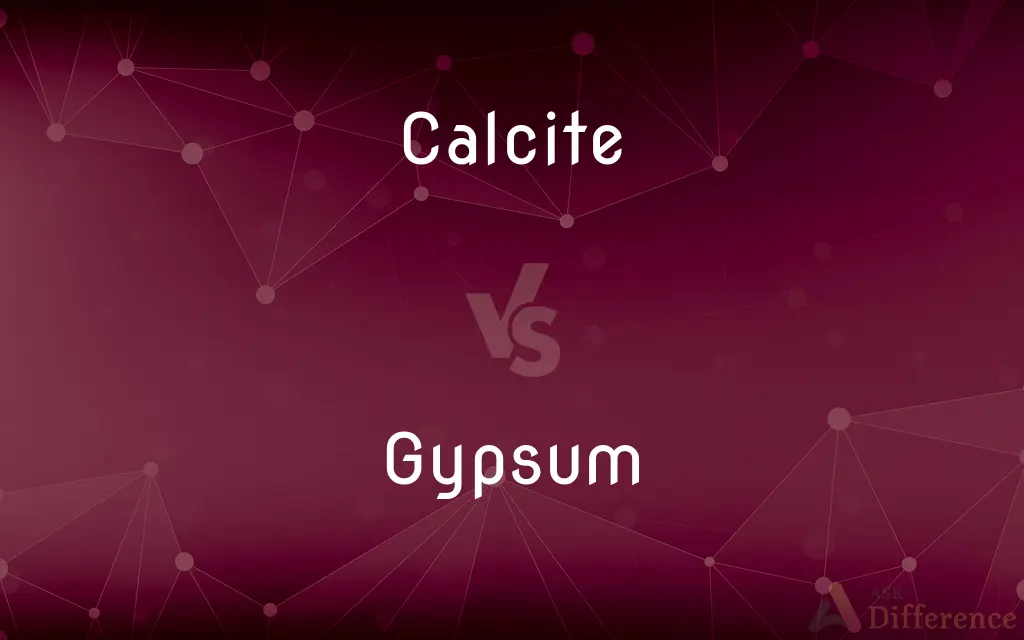Calcite vs. Gypsum — What's the Difference?
By Maham Liaqat & Fiza Rafique — Updated on March 11, 2024
Calcite is a carbonate mineral known for its rhombohedral cleavage and reaction with dilute hydrochloric acid, while gypsum is a sulfate mineral, softer, with a hardness of 2 and used in plaster.

Difference Between Calcite and Gypsum
Table of Contents
ADVERTISEMENT
Key Differences
Calcite, primarily composed of calcium carbonate (CaCO3), is recognized for its widespread occurrence in sedimentary, metamorphic, and igneous rocks. It exhibits a characteristic rhombohedral cleavage that makes it unique among minerals. On the other hand, gypsum, consisting of calcium sulfate dihydrate (CaSO4·2H2O), is noted for its softness, ranking at 2 on the Mohs hardness scale, and its role as a primary material in the manufacture of plaster and drywall.
Calcite reacts vigorously with dilute hydrochloric acid, producing carbon dioxide bubbles, a diagnostic feature not seen with gypsum. This reaction is a handy field test for geologists. Whereas gypsum, when mixed with water, can form a smooth paste that hardens over time, making it essential for construction and artistic applications.
Calcite’s optical properties are significant, exhibiting double refraction where an image seen through a clear piece of calcite will appear doubled. Gypsum, while also transparent to translucent, does not demonstrate this optical feature but can exhibit a satin spar variety that is fibrous and silky.
The environmental conditions under which calcite forms include both organic and inorganic processes, often precipitating in marine settings where it can form extensive limestone deposits. In contrast, gypsum forms in evaporative environments like salt flats and lakes, where it can create massive sedimentary beds.
Calcite is a key mineral in the construction industry, used as a building material and in the manufacture of cement and lime. Gypsum's economic importance lies in its use in plaster, plasterboard, and as an agricultural soil amendment to improve soil structure.
ADVERTISEMENT
Comparison Chart
Composition
Calcium carbonate (CaCO3)
Calcium sulfate dihydrate (CaSO4·2H2O)
Hardness
3 on the Mohs scale
2 on the Mohs scale
Industrial Use
Cement, lime manufacturing
Plaster, drywall production
Optical Property
Exhibits double refraction
Does not exhibit double refraction
Formation Environment
Marine settings, caves
Evaporative environments, salt flats
Compare with Definitions
Calcite
Its crystal structure allows for a wide variety of shapes and sizes.
The spectacular stalactites and stalagmites in caves are often composed of calcite.
Gypsum
A soft sulfate mineral, crucial for plaster and drywall.
Gypsum board is commonly used in building construction.
Calcite
Calcite's double refraction property splits light into two paths.
Icelandic spar is a clear variety of calcite known for its strong double refraction.
Gypsum
Used in agriculture to improve soil structure.
Farmers add gypsum to heavy clay soils to enhance drainage.
Calcite
A common naturally occurring mineral, calcite forms in various colors due to impurities.
Calcite veins in rocks often indicate hydrothermal activity.
Gypsum
It forms in sedimentary layers, often associated with limestone.
The White Sands National Monument contains large gypsum dunes.
Calcite
It's a major component of marine sedimentary rocks.
Limestone, composed largely of calcite, forms from marine organisms' skeletal material.
Gypsum
It's a key ingredient in plaster of Paris.
Artists use plaster of Paris, derived from gypsum, for sculptures and molds.
Calcite
Calcite reacts with acid to fizz or effervesce.
Geologists use hydrochloric acid on rocks to test for calcite.
Gypsum
Gypsum can form transparent crystals called selenite.
Selenite crystals are prized for their clarity and luster.
Calcite
Calcite is a carbonate mineral and the most stable polymorph of calcium carbonate (CaCO3). The Mohs scale of mineral hardness, based on scratch hardness comparison, defines value 3 as "calcite".
Gypsum
Gypsum is a soft sulfate mineral composed of calcium sulfate dihydrate, with the chemical formula CaSO4·2H2O. It is widely mined and is used as a fertilizer and as the main constituent in many forms of plaster, blackboard/sidewalk chalk, and drywall. A massive fine-grained white or lightly tinted variety of gypsum, called alabaster, has been used for sculpture by many cultures including Ancient Egypt, Mesopotamia, Ancient Rome, the Byzantine Empire, and the Nottingham alabasters of Medieval England.
Calcite
A common crystalline form of natural calcium carbonate, CaCO3, that is the basic constituent of limestone, marble, and chalk. Also called calcspar.
Gypsum
A widespread colorless, white, or yellowish mineral, CaSO4·2H2O, used in the manufacture of plaster of Paris, various plaster products, and fertilizers.
Calcite
(mineral) a very widely distributed crystalline form of calcium carbonate, CaCO3, found as limestone, chalk and marble
Gypsum
A mineral consisting of hydrated calcium sulphate. When calcinated, it forms plaster of Paris.
Calcite
Calcium carbonate, or carbonate of lime. It is rhombohedral in its crystallization, and thus distinguished from aragonite. It includes common limestone, chalk, and marble. Called also calc-spar and calcareous spar.
Gypsum
A mineral consisting of the hydrous sulphate of lime (calcium). When calcined, it forms plaster of Paris. Selenite is a transparent, crystalline variety; alabaster, a fine, white, massive variety.
Calcite
A common mineral consisting of crystallized calcium carbonate; a major constituent of limestone
Gypsum
A common white or colorless mineral (hydrated calcium sulphate) used to make cements and plasters (especially plaster of Paris)
Common Curiosities
How can gypsum be identified in the field?
Gypsum can be identified by its softness, as it can be easily scratched with a fingernail, and its solubility in water.
What makes calcite easily distinguishable from other minerals?
Its rhombohedral cleavage and reaction with dilute hydrochloric acid, producing bubbles, make calcite easily distinguishable.
Can gypsum form in any type of environment?
Gypsum primarily forms in evaporative environments such as salt flats and lakes where water evaporates, leaving behind sulfate minerals.
What is the significance of double refraction in calcite?
Double refraction in calcite has applications in polarized light microscopy and optical instruments.
How do gypsum's properties make it suitable for plaster and drywall?
Its solubility and ability to form a smooth paste that hardens make it ideal for plaster and drywall.
Why is calcite important to the environment?
Calcite plays a crucial role in carbon cycling and is a major component of limestone, which can act as a carbon reservoir.
What role does gypsum play in sustainable agriculture?
Gypsum is used to improve soil structure, aeration, and water penetration, promoting sustainable agriculture.
Can calcite be used in water treatment?
Yes, calcite can be used in water treatment as a pH stabilizer and to remineralize demineralized or desalinated water.
How does the softness of gypsum affect its uses?
Its softness makes it ideal for use in plaster and drywall, as it can be easily shaped, carved, and smoothed.
What is the primary use of calcite?
Calcite is primarily used in the construction industry, particularly in the manufacture of cement and lime.
Is gypsum used in food production?
Yes, food-grade gypsum is used as a coagulant in products like tofu.
How does the formation of calcite contribute to the landscape?
Calcite contributes to the landscape through the formation of geological features like stalactites, stalagmites, and limestone mountains.
What environmental conditions favor the formation of calcite?
Calcite forms in a variety of environmental conditions, including marine settings, hot springs, and caves.
What is the difference in hardness between calcite and gypsum?
Calcite has a Mohs hardness of 3, making it slightly harder than gypsum, which has a hardness of 2.
How do calcite and gypsum contribute to the economy?
Calcite is vital in the cement and lime industry, while gypsum is essential in construction for plaster and drywall, both contributing significantly to their respective sectors.
Share Your Discovery

Previous Comparison
Parka vs. Cagoule
Next Comparison
Transitory vs. TransientAuthor Spotlight
Written by
Maham LiaqatCo-written by
Fiza RafiqueFiza Rafique is a skilled content writer at AskDifference.com, where she meticulously refines and enhances written pieces. Drawing from her vast editorial expertise, Fiza ensures clarity, accuracy, and precision in every article. Passionate about language, she continually seeks to elevate the quality of content for readers worldwide.














































